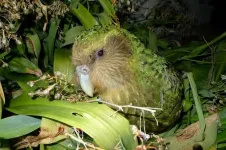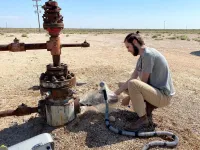In wild soil, predatory bacteria grow faster than their prey
2021-04-28
(Press-News.org) Predatory bacteria--bacteria that eat other bacteria--grow faster and consume more resources than non-predators in the same soil, according to a new study out this week from Northern Arizona University. These active predators, which use wolfpack-like behavior, enzymes, and cytoskeletal 'fangs' to hunt and feast on other bacteria, wield important power in determining where soil nutrients go. The results of the study, published in the journal mBio this week, show predation is an important dynamic in the wild microbial realm, and suggest that these predators play an outsized role in how elements are stored in or released from soil.
Like every other life form on earth, bacteria belong to intricate food webs in which organisms are connected to one another by whom they consume and how. In macro webs, ecologists have long understood that when resources like grass and shrubs are added to lower levels of the web, predators at the top, such as wolves, often benefit. The research team, led by Bruce Hungate and researchers from Northern Arizona University and Lawrence Livermore Laboratory, wanted to test whether the same was true in the microbial food webs found in wild soil.
"We've known predation plays a role in maintaining soil health, but we didn't appreciate how significant predator bacteria are to these ecosystems before now," said Hungate, who directs the Center for Ecosystem Science and Society at Northern Arizona University.
To understand who and how much predator bacteria were consuming, the research team assembled a big picture using dozens of smaller data "snapshots": 82 sets of data from 15 sites in a range of ecosystems. The team used information about how bacteria behave in culture to categorize bacteria as obligate or facultative predators. About seven percent of all bacteria in the meta-analysis were identified as predators, and the majority of those were facultative, or omnivorous.
Obligate predator bacteria like Bdellovibrionales and Vampirovibrionales grew 36 percent faster and took up carbon 211 percent faster than non-predators did. When the soil received a boost of carbon, predator bacteria used it to grow faster than other types. Researchers saw these effects in the omnivorous bacteria, as well, though the differences were less profound.
All the experiments were conducted using a state-of-the-art technique called quantitative Stable Isotope Probing, or qSIP. Researchers used labeled isotopes, which act a little like molecular hashtags, to track who is active and taking up nutrients in the soil. By sequencing the DNA in a soil sample and looking for these labels, the team could see who was growing and eating whom at the level of bacterial taxa.
"While analyzing my data, I noticed that Vampirovibrio was super enriched. Since we know Vampirovibrio is a predator, I became interested in looking for other potential predators in my other data," said Brianna Finley, a postdoctoral research at University of California-Irvine and co-author on the study. "That we could pick up on these signals really validates qSIP as a tool."
Soil ecosystems contain more carbon than is stored in all the plants on Earth, so understanding how carbon and other elements move among soil organisms is crucial to predicting future climate change. And because bacteria are so abundant in soil, they have an enormous role in how nutrients are stored there or lost. And learning more about how predator bacteria act as 'antibiotics' could have therapeutic implications, down the road.
"Until now, predatory bacteria have not been a part of that soil story," said Hungate. "But this study suggests that they are important characters who have a significant role determining the fate of carbon and other elements. These findings motivate us to take a deeper look at predation as a process."
INFORMATION:
The research was supported by the Department of Energy's Office of Biological and Environmental Research Genomic Sciences Program, and a Lawrence Fellow award from the Lawrence Livermore National Laboratory.
ELSE PRESS RELEASES FROM THIS DATE:
2021-04-28
Constantina Theofanopoulou wanted to study oxytocin. Her graduate work had focused on how the hormone influences human speech development, and now she was preparing to use those findings to investigate how songbirds learn to sing. The problem was that birds do not have oxytocin. Or so she was told.
"Everywhere that I looked in the genome," she says, "I was unable to find a gene called oxytocin in birds."
Theofanopoulou eventually came across mesotocin, the analogue for oxytocin in birds, reptiles, and amphibians. But as she plumped the literature in Erich Jarvis's lab at Rockefeller, the waters grew muddier. If she and Jarvis wanted to find studies on oxytocin in fish, they ...
2021-04-28
Researchers from Erasmus School of Economics, IESE Business School, and New York University published a new paper in the Journal of Marketing that examines what business schools do wrong when conducting academic research and what changes they can make so that research contributes to improving society.
The study, forthcoming in the Journal of Marketing, is titled "Faculty Research Incentives and Business School Health: A New Perspective from and for Marketing" and is authored by Stefan Stremersch, Russell Winer, and Nuno Camacho.
In February 2020, an article in ...
2021-04-28
The flightless kakapo of New Zealand is in trouble. The world's heaviest parrot--representing one of the most ancestral branches of the parrot family tree--is nearly extinct, with barely 200 adults plodding the underbrush of four small islands. Whether the last of the kakapos had the genetic resilience to survive was a question that only high-quality genomic analysis could answer.
But a high-quality genome assembly did not exist for the kakapo--nor for most of the 70,000 vertebrate species alive today.
Questions about how best to prevent the extinction of species ranging ...
2021-04-28
ROCHESTER, Minn. -- Difficult-to-treat, chronic wounds in preclinical models healed with normal scar-free skin after treatment with an acellular product discovered at Mayo Clinic. Derived from platelets, the purified exosomal product, known as PEP, was used to deliver healing messages into cells of preclinical animal models of ischemic wounds. The Mayo Clinic research team documented restoration of skin integrity, hair follicles, sweat glands, skin oils and normal hydration.
Ischemic wounds occur when arteries are clogged or blocked, preventing important nutrients and oxygen from reaching the skin to drive repair. This groundbreaking study titled, "TGF-β Donor Exosome Accelerates Ischemic ...
2021-04-28
To be more energy efficient, many people have replaced their incandescent lights with light-emitting diode (LED) bulbs. However, those currently on the market emit a lot of blue light, which has been linked to eye troubles and sleep disturbances. Now, researchers reporting in ACS Applied Materials & Interfaces have developed a prototype LED that reduces -- instead of masks -- the blue component, while also making colors appear just as they do in natural sunlight.
LED light bulbs are popular because of their low energy consumption, long lifespan and ability to turn on and off quickly. Inside the bulb, an LED chip converts electrical current into high-energy light, including invisible ultraviolet (UV), violet ...
2021-04-28
The highly infectious SARS-CoV-2 variant that recently emerged in South Africa, known as B.1.351, has scientists wondering how existing COVID-19 vaccines and therapies can be improved to ensure strong protection. Now, researchers reporting in ACS' Journal of Medicinal Chemistry have used computer modeling to reveal that one of the three mutations that make variant B.1.351 different from the original SARS-CoV-2 reduces the virus' binding to human cells -- but potentially allows it to escape some antibodies.
Since the original SARS-CoV-2 was first detected in late 2019, several new variants have emerged, including ones from the U.K., South Africa and Brazil. Because the new variants appear to be more highly ...
2021-04-28
Uncapped, idle oil wells could be leaking millions of kilograms of methane each year into the atmosphere and surface water, according to a study by the University of Cincinnati.
Amy Townsend-Small, an associate professor of geology and geography in UC's College of Arts and Sciences, studied 37 wells on private property in the Permian Basin of Texas, the largest oil production region on Earth. She found that seven had methane emissions of as much as 132 grams per hour. The average rate was 6.2 grams per hour.
"Some of them were leaking a lot. Most of them were leaking a little or not at all, which is a ...
2021-04-28
April 28, 2021 -- Using naturalistic driving data and machine learning techniques, researchers at Columbia University Mailman School of Public Health and Columbia's Fu Foundation School of Engineering and Applied Science have developed highly accurate algorithms for detecting mild cognitive impairment and dementia in older drivers. Naturalistic driving data refer to data captured through in-vehicle recording devices or other technologies in the real-world setting. These data could be processed to measure driving exposure, space and performance in great detail. The findings are published in the journal Geriatrics.
The researchers developed random forests models, a statistical technique ...
2021-04-28
People of color, those with a higher income and younger individuals are more likely to participate in clinical trials during their cancer treatment according to a new study from the University of Missouri School of Medicine.
Clinical trials are research studies that involve people who volunteer to take part in tests of new drugs, current approved drugs for a new purpose or medical devices.
The study analyzed data collected from the Centers for Disease Control and Prevention (CDC) Behavioral Risk Factor Surveillance System Survey, which is an annual national telephone survey designed to collect health-related data from U.S. adults. Survey years selected included the question, "Did you participate in a clinical trial ...
2021-04-28
Chocolate is a beloved treat, but sometimes the cocoa beans that go into bars and other sweets have unpleasant flavors or scents, making the final products taste bad. Surprisingly, only a few compounds associated with these stinky odors are known. Now, researchers reporting in ACS' Journal of Agricultural and Food Chemistry have identified the two compounds that cause musty, moldy scents in cocoa -- work that can help chocolatiers ensure the quality of their products.
Cocoa beans, when fermented correctly, have a pleasant smell with sweet and floral notes. But they can have an off-putting scent when fermentation goes wrong, or when storage conditions ...
LAST 30 PRESS RELEASES:
[Press-News.org] In wild soil, predatory bacteria grow faster than their prey


